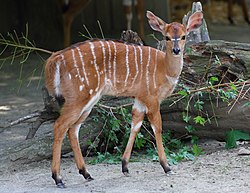Nyala
The Nyala comes from the Bovia Gray family and subfamily the Bovinae family, including animals like antelopes, cattle ,goats, sheep, and bushbucks. [1]The Nyala species is known for their great agility and being able to navigate harsh environment with their muscular legs and unique cloven hooves.
| Nyala | |
|---|---|

| |
| Male | |

| |
| Female | |
| Conservation status | |
| Scientific classification | |
| Kingdom: | |
| Phylum: | |
| Class: | |
| Order: | |
| Family: | |
| Genus: | Nyala
|
| Species: | N. angasii
|
| Binomial name | |
| Nyala angasii (Angas, 1849)
| |

| |
| Geographic range | |
| Synonyms[3] | |
| |
The nyala (Nyala angasii or Tragelaphus angasii), also called inyala,[4] is an antelope that lives in southern Africa. It has the highest sexual dimorphism among other spiral-horned antelopes.
The nyala is mainly active early in the morning and late in the afternoon. As a herbivore, the nyala eats leaves, fruits and grasses. They prefer water holes rather than open spaces. The nyala is not a territorial animal. Family groups of up to 10 individuals can be found. Old males live alone but family groups of up to ten members live in thickets within dense and dry savanna woodlands. The main predators of the nyala are lion, leopard and Cape hunting dog, while baboons and raptors hunt for the young. Mating peaks during spring and autumn.
Nyalas live in Malawi, Mozambique, South Africa, Swaziland and Zimbabwe. They have been introduced to Botswana and Namibia, and reintroduced to Swaziland, where they became extinct in the 1950s. Populations are stable and are of Least Concern by the International Union for Conservation of Nature (IUCN). The main threats to the species are poaching and habitat loss resulting from human settlement. The males are highly demanded as game animals in Africa.
References
- ↑ Tello, José L. P. Lobão; Van Gelder, Richard George (1975). "The natural history of nyala, Tragelaphus angasi (Mammalia, Bovidae) in Mozambique. Bulletin of the AMNH ; v. 155, article 4".
{{cite journal}}: Cite journal requires|journal=(help) - ↑ IUCN redlist(2014) International Union for Conservation of Nature and Natural Resources, accessed 23 July 2014. Database entry includes a brief justification of why this species is of least concern.
- ↑ Tragelaphus angasii (22 March 2004) Brent Huffman, accessed 23 July 2014
- ↑ H A Bryden; A J Arnold; et al, Great and Small Game of Africa: An Account of the Distribution, Habits, and Natural History of the Sporting Mammals, with Personal Hunting Experiences (London: R. Ward, 1899), p. 455
